Can You Put Wood Floors in a Bathroom?
March 13, 2024 | By Bruce Product Expert
But what if you’re sold on everything natural wood flooring offers? Its natural beauty, durability, longevity, and warmth. Well, fortunately, there’s an answer — waterproof wood flooring.
Bathrooms Have High Humidity
To state the obvious, there’s one massive concern about hardwood in a bathroom. Water. Wood floors and moisture are like oil and water — they don’t mix well.
Unfortunately, when installing hardwood floors in a bathroom, you will encounter water concerns. That’s even true in powder rooms in many cases.
First, bathrooms have high humidity, infinitely more so than other rooms in your house. You might be more concerned about water splashing on the surface of your wood floor. But humidity has an equally damaging effect.
If you take a hot morning shower, you can see how much by looking at your mirror. Ever notice how moisture blankets it after a steamy shower? Well, that moisture also falls onto your wood flooring.
Other Water Concerns in a Bathroom
Humidity aside, you face other water concerns by installing wood flooring in a bathroom.
Sinks, showers, and bathtubs create spills and splashes. Kids like to play in the tub, leading to inevitable splashing on your floors. Have you ever washed a dog in your bathroom tub? That’s more chances of getting water on your wood flooring.
You’ll get water on your bathroom floor no matter how hard you try.
Moreover, plumbing fixtures can leak or, worse still, burst and flood your bathroom floor with water. And any amount of standing water on a wooden floor will have dire consequences.
You also need to ensure that your bathroom floor is 100% level. Otherwise, water will pool in low areas. That pooling water won’t take long to destroy your wood floor.
Addressing Concerns About Bathroom Flooring
Now that you know water is the enemy of your wood flooring, you can take steps to combat the issue. Here are some things you can do:
1. Ceiling Fan: They help remove high humidity from your bathroom. So, turn on your ceiling fan whenever you shower to draw moisture from the room.
2. Bathmats: Place bathmats outside your tub or shower and in front of your sink. Use mats with a rubber backing to prevent water from reaching your wood floors.
3. Wipe Up Spills: If you see water on your wood floor, wipe it up. Immediately. Whatever you do, never allow it to seep into the wood.
4. Plumbing: Check your plumbing regularly for problems and fix them before they become more significant issues
5. Wood Floor Finish: Keep an eye on your floor’s finish. If you see an area where water isn’t beading, add a topcoat to prevent water from penetrating your wood floors.
Protecting Wood Floors in Bathrooms – The Water Drop Trick
Here’s a trick worth knowing. Let a few drops of water fall on the wood flooring in your bathroom. If the wood doesn’t absorb the drops, your floor’s finish still protects the wood. Otherwise, you should add to the finish to prevent water absorption.
And therein lies a plus with wood flooring. If your floors look worn or appear to be absorbing water, you can sand and refinish them.
You can refinish solid hardwood anywhere from two to five times. You can do the same with engineered hardwood, though less often, perhaps twice.
Wood floors in a bathroom may require a bit more maintenance than tile floors. But the upside is that they’ll add depth and character to your bathroom that few other floors can match.
Tips for Selecting Wood Flooring in Your Bathroom
The type of wood flooring you select for a bathroom plays a hand in avoiding issues with water. Here are some considerations:
Tip #1: Don’t purchase wood flooring with softwoods like pine. They’re less dense, making them more susceptible to moisture absorption.
Tip #2: Go for dense hardwoods like oak, maple, hickory, walnut, or teak. These hardwoods feature dense grains that prevent water penetration, even without a finish. They also resist warping, cracking, twisting, and decaying.
White oak is one of the best wood floors in a bathroom. It handles humidity better than maple, for example. The graining helps prevent water from penetrating through knots or cracks.
Tip #3: Pay close attention to the finish. The better the finish, the better the water resistance. Opt for wood flooring in your bathroom that includes an aluminum oxide finish. It helps prevent water absorption.
Equally important, it improves the floor’s resistance to scratches and wear.
Tip #4: Use engineered hardwood instead of solid hardwood. Keep reading to learn why.
Solid Hardwood vs. Engineered Hardwood Flooring
Solid hardwood flooring uses a single piece of wood for each plank. As discussed, however, wood absorbs water. So, the smart money is to avoid placing solid hardwood in moisture-prone areas like bathrooms.
However, engineered hardwood flooring addresses a good bit of that concern. Rather than a single piece of hardwood, engineered wood flooring uses a real wood veneer. So, your floors look exactly like solid hardwood floors, primarily because they are authentic.
The magic takes place in the core layers of the floor’s planks. That core is woven and glued. More importantly, it uses a crisscrossed pattern, adding structural integrity to each plank. That makes engineered hardwood less likely to expand and contract when exposed to water.
That doesn’t mean engineered floors are waterproof. They are water resistant…
Waterproof Wood Flooring for Bathrooms
Yes, waterproof hardwoods do exist. For example, Bruce® manufactures Hydropel™, a waterproof engineered hardwood floor.
Hyrdropel has six water protection dimensions on each plank’s top, bottom, sides, and ends. Its hyper-dense core also keeps the flooring safe from water damage.
You can use the product dependably. The waterproof wood flooring comes with a 50-Year Residential Warranty. It also offers superior protection against scratches, stains, and wear.
Ready to Install Wood Flooring in Your Bathroom?
No question using wood floors in a bathroom requires some diligence. You must wipe up excess water or risk damaging your floors. You should also take other precautions – ceiling vents, mats, and a tub surround.
But if you’re open to that extra effort, you’ll enjoy the timeless appeal of wood floors in your bathroom.
Bruce removes much of the burden associated with wood flooring in bathrooms. It delivers 100% waterproof protection. So, you’ll get the beauty of natural hardwood without the moisture concerns.
Use our retailer locator to find the Bruce dealer near you.

Ready to shop for hickory flooring near you?
Use our retail locator to find where you can buy Bruce oak flooring.
Find a Store
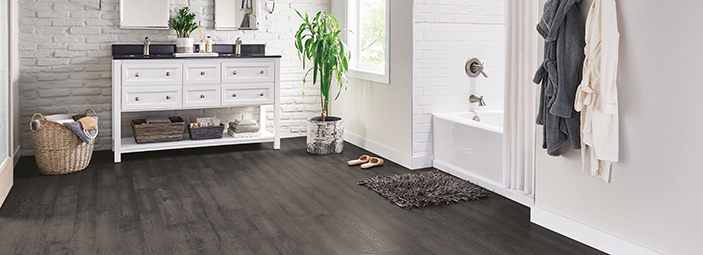
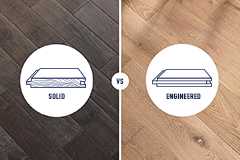 Solid vs Engineered Hardwood Flooring
Solid vs Engineered Hardwood Flooring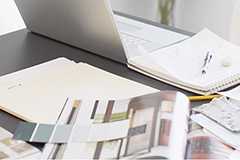 Guide To Choosing a Hardwood Floor
Guide To Choosing a Hardwood Floor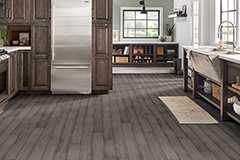 Hardwood Flooring Room Inspiration Guide
Hardwood Flooring Room Inspiration Guide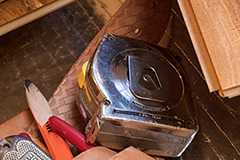 10 Things to Know About Hardwood Floor Installation
10 Things to Know About Hardwood Floor Installation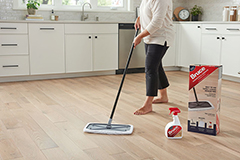 How To Clean and Protect Hardwood Flooring
How To Clean and Protect Hardwood Flooring